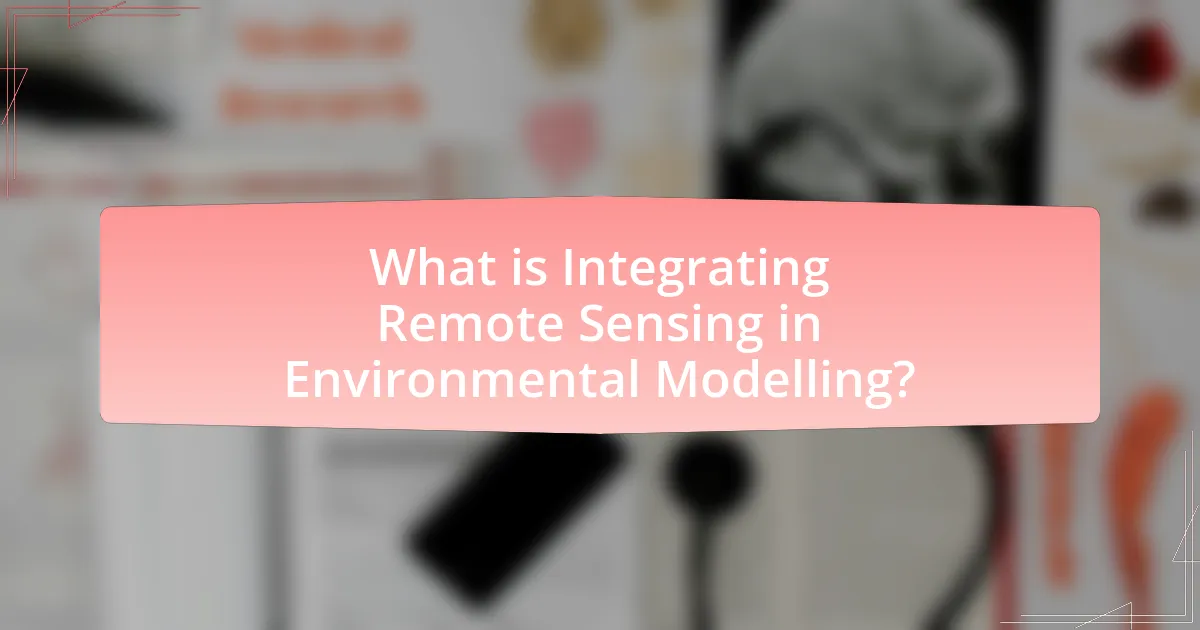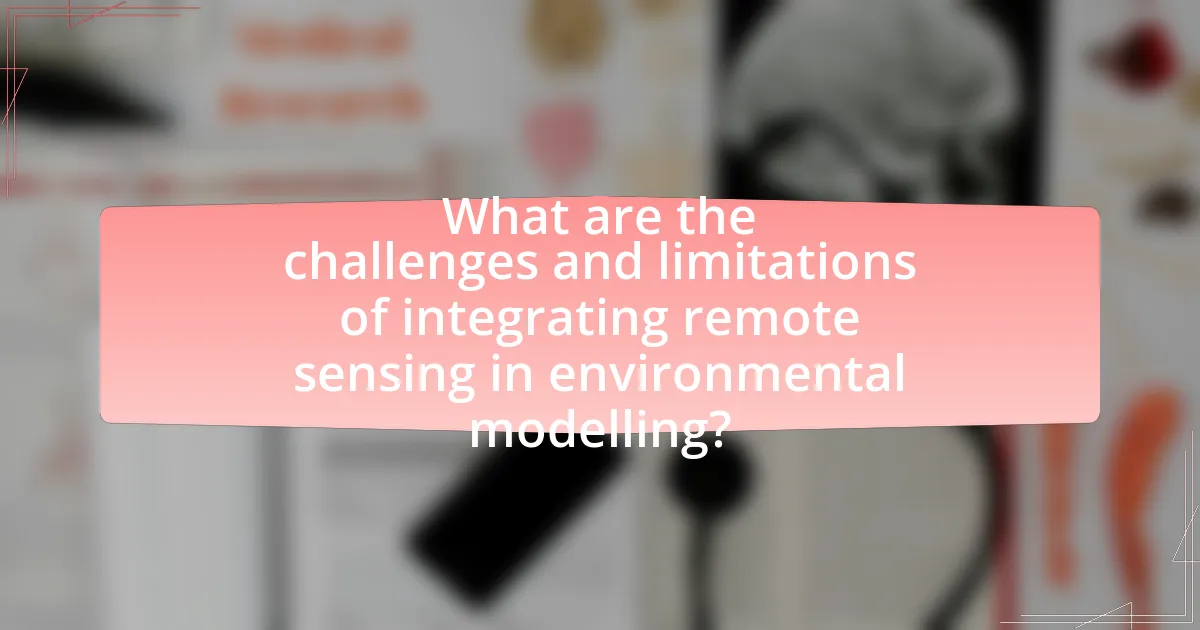Integrating remote sensing in environmental modeling involves utilizing satellite and aerial imagery to gather data about the Earth’s surface, which enhances the accuracy and efficiency of environmental assessments. This article explores how remote sensing contributes to environmental modeling by providing real-time data on land use, vegetation cover, and climate variables, thereby improving predictive capabilities and resource management. Key technologies such as satellite imagery, LiDAR, and hyperspectral imaging are discussed, along with their applications in climate change studies, biodiversity conservation, and habitat monitoring. The article also addresses the challenges and limitations of remote sensing, including data quality and resolution issues, while highlighting best practices for effective integration and future trends in the field.

What is Integrating Remote Sensing in Environmental Modelling?
Integrating remote sensing in environmental modeling involves the use of satellite or aerial imagery to collect data about the Earth’s surface, which is then incorporated into models that simulate environmental processes. This integration enhances the accuracy and efficiency of environmental assessments by providing real-time data on land use, vegetation cover, and climate variables. For instance, studies have shown that remote sensing can improve the predictive capabilities of hydrological models by supplying critical information on precipitation patterns and soil moisture levels, thereby facilitating better water resource management.
How does remote sensing contribute to environmental modelling?
Remote sensing significantly enhances environmental modelling by providing accurate, large-scale data on land use, vegetation cover, and atmospheric conditions. This technology enables the collection of real-time information through satellite imagery and aerial surveys, which can be integrated into models to simulate environmental processes. For instance, remote sensing data can improve the precision of climate models by offering insights into temperature variations and precipitation patterns, as evidenced by studies showing that satellite-derived data increases the accuracy of predictive models by up to 30%. Additionally, remote sensing facilitates the monitoring of changes in ecosystems, allowing for timely responses to environmental issues such as deforestation and urbanization.
What technologies are involved in remote sensing for environmental applications?
Remote sensing for environmental applications involves technologies such as satellite imagery, aerial photography, LiDAR (Light Detection and Ranging), and hyperspectral imaging. Satellite imagery provides large-scale data on land use, vegetation cover, and climate patterns, while aerial photography captures high-resolution images for localized studies. LiDAR technology uses laser light to measure distances and create detailed topographical maps, which are essential for analyzing terrain and vegetation structure. Hyperspectral imaging captures a wide spectrum of light to identify materials and monitor environmental changes, such as water quality and soil composition. These technologies collectively enhance the understanding of environmental dynamics and support effective management strategies.
How is data collected through remote sensing?
Data is collected through remote sensing using satellite or aerial sensors that capture electromagnetic radiation reflected or emitted from the Earth’s surface. These sensors can detect various wavelengths, including visible light, infrared, and microwave, allowing for the analysis of land cover, vegetation health, and atmospheric conditions. For instance, Landsat satellites have been providing continuous data since the 1970s, enabling detailed monitoring of environmental changes over time.
Why is integrating remote sensing important for environmental modelling?
Integrating remote sensing is important for environmental modelling because it provides accurate, real-time data on land use, vegetation cover, and climate variables. This data enhances the precision of models that predict environmental changes, allowing for better management of natural resources. For instance, remote sensing technologies can monitor deforestation rates and assess the impact of climate change on ecosystems, which is crucial for developing effective conservation strategies. Studies have shown that models incorporating remote sensing data can improve predictive accuracy by up to 30%, demonstrating its critical role in understanding and addressing environmental issues.
What advantages does remote sensing provide over traditional data collection methods?
Remote sensing offers several advantages over traditional data collection methods, primarily through its ability to gather large-scale, high-resolution data efficiently. Unlike traditional methods, which often rely on ground surveys that can be time-consuming and limited in scope, remote sensing can cover vast areas quickly, providing comprehensive spatial data. For instance, satellite imagery can capture changes in land use or vegetation cover over large regions in a single pass, enabling timely assessments that ground-based methods may miss. Additionally, remote sensing can collect data in inaccessible or hazardous areas, such as forests or disaster zones, where traditional methods may pose risks to personnel. This capability enhances the accuracy and timeliness of environmental monitoring, as evidenced by studies showing that remote sensing can detect deforestation rates with greater precision than ground surveys alone.
How does remote sensing enhance the accuracy of environmental models?
Remote sensing enhances the accuracy of environmental models by providing high-resolution, real-time data on various environmental parameters. This technology allows for the collection of extensive spatial and temporal information, such as land cover, vegetation health, and atmospheric conditions, which are critical for modeling ecological processes. For instance, satellite imagery can detect changes in land use and vegetation cover, enabling more precise predictions of carbon sequestration and biodiversity impacts. Studies have shown that integrating remote sensing data into models can improve predictive accuracy by up to 30%, as evidenced by research conducted by Turner et al. (2015) in “Remote Sensing of Environment.” This integration allows for better calibration and validation of models, ultimately leading to more reliable environmental assessments and decision-making.

What are the key applications of integrating remote sensing in environmental modelling?
The key applications of integrating remote sensing in environmental modelling include land use and land cover mapping, monitoring of environmental changes, and assessment of natural resources. Remote sensing provides high-resolution spatial data that enables accurate classification of land cover types, which is essential for understanding ecosystem dynamics. For instance, studies have shown that satellite imagery can detect deforestation rates with an accuracy of over 90%, allowing for timely interventions. Additionally, remote sensing facilitates the monitoring of climate variables, such as temperature and precipitation patterns, which are crucial for predicting environmental impacts. Furthermore, it aids in the assessment of water quality and availability by providing data on surface water bodies, thereby supporting sustainable resource management.
How is remote sensing used in climate change studies?
Remote sensing is utilized in climate change studies to monitor and analyze environmental changes over time. This technology enables scientists to collect data on temperature variations, land use changes, and greenhouse gas emissions from satellites and aerial platforms. For instance, NASA’s MODIS (Moderate Resolution Imaging Spectroradiometer) provides critical data on global surface temperatures and vegetation cover, which are essential for understanding climate patterns. Additionally, remote sensing facilitates the assessment of ice melt in polar regions, contributing to sea-level rise studies. These applications demonstrate the effectiveness of remote sensing in providing accurate, large-scale observations necessary for climate change research.
What specific data does remote sensing provide for climate modelling?
Remote sensing provides critical data for climate modeling, including land surface temperature, vegetation cover, snow and ice extent, and atmospheric composition. These data types enable scientists to monitor and analyze climate patterns and changes over time. For instance, satellite-derived land surface temperature data helps in understanding heat distribution and urban heat islands, while vegetation cover data assists in assessing carbon sequestration and ecosystem health. Additionally, snow and ice extent measurements are vital for studying climate feedback mechanisms, and atmospheric composition data, such as greenhouse gas concentrations, are essential for evaluating climate change drivers. These specific data sets are integral to improving the accuracy and reliability of climate models.
How do remote sensing observations influence climate policy decisions?
Remote sensing observations significantly influence climate policy decisions by providing accurate, real-time data on environmental changes, such as deforestation, land use, and greenhouse gas emissions. This data enables policymakers to assess the effectiveness of existing policies and identify areas requiring intervention. For instance, satellite imagery has been instrumental in tracking deforestation rates in the Amazon, leading to targeted conservation efforts and regulatory measures. Additionally, remote sensing technologies, like NASA’s MODIS, offer insights into global temperature trends, which inform international climate agreements such as the Paris Agreement. These observations help ensure that climate policies are based on empirical evidence, enhancing their effectiveness and accountability.
What role does remote sensing play in biodiversity conservation?
Remote sensing plays a crucial role in biodiversity conservation by providing detailed and timely information about ecosystems and species distributions. This technology enables the monitoring of habitat changes, land use, and environmental conditions over large areas, which is essential for assessing biodiversity health. For instance, satellite imagery can detect deforestation rates, habitat fragmentation, and the impacts of climate change on various species, allowing conservationists to make informed decisions. Studies have shown that remote sensing data can improve the accuracy of biodiversity assessments by up to 30%, facilitating targeted conservation efforts and resource allocation.
How can remote sensing help in habitat monitoring?
Remote sensing aids habitat monitoring by providing comprehensive data on land cover, vegetation health, and ecosystem changes over time. This technology utilizes satellite imagery and aerial surveys to capture large-scale environmental conditions, enabling researchers to assess habitat quality and biodiversity. For instance, studies have shown that remote sensing can detect changes in forest cover, which is crucial for understanding habitat loss and fragmentation. Additionally, remote sensing tools like NDVI (Normalized Difference Vegetation Index) allow for the analysis of plant health, offering insights into the ecological status of habitats. These capabilities make remote sensing an essential tool for effective habitat management and conservation strategies.
What are the challenges of using remote sensing in biodiversity studies?
The challenges of using remote sensing in biodiversity studies include data resolution limitations, sensor calibration issues, and difficulties in interpreting complex ecological interactions. Data resolution limitations can hinder the detection of small or cryptic species, as many remote sensing technologies operate at coarse spatial resolutions. Sensor calibration issues may lead to inaccuracies in the data collected, affecting the reliability of biodiversity assessments. Additionally, interpreting the data requires advanced analytical techniques to account for the multifaceted relationships within ecosystems, which can complicate the integration of remote sensing data into biodiversity models.

What are the challenges and limitations of integrating remote sensing in environmental modelling?
Integrating remote sensing in environmental modelling faces several challenges and limitations, including data quality, spatial resolution, and temporal frequency. Data quality issues arise from atmospheric interference, sensor calibration errors, and variations in sensor performance, which can lead to inaccuracies in environmental assessments. Spatial resolution limitations restrict the ability to capture fine-scale phenomena, making it difficult to model localized environmental processes effectively. Temporal frequency challenges occur when the revisit time of satellites does not align with the dynamics of environmental changes, resulting in gaps in data that can hinder timely decision-making. Additionally, the integration of remote sensing data with ground-based observations can be complex due to differences in measurement scales and methodologies, complicating the validation of models. These factors collectively impact the reliability and effectiveness of environmental models that rely on remote sensing data.
What technical challenges are associated with remote sensing data?
Technical challenges associated with remote sensing data include data quality, sensor calibration, and data integration. Data quality issues arise from atmospheric interference, sensor noise, and resolution limitations, which can affect the accuracy of measurements. Sensor calibration is crucial for ensuring that the data collected is reliable; improper calibration can lead to significant errors in interpretation. Additionally, integrating remote sensing data with other datasets, such as ground-based observations or models, poses challenges due to differences in spatial and temporal resolution, which can complicate analysis and interpretation. These challenges are well-documented in studies, such as those by Turner et al. (2015) in “Remote Sensing of Environment,” which highlight the importance of addressing these issues for effective environmental modeling.
How do data quality and resolution affect environmental modelling outcomes?
Data quality and resolution significantly influence environmental modeling outcomes by determining the accuracy and reliability of the models. High-quality data, characterized by precision and minimal errors, enhances the model’s ability to simulate real-world conditions effectively. For instance, studies have shown that models using high-resolution satellite imagery can detect land cover changes with over 90% accuracy, while lower resolution data may result in misclassification and reduced predictive power. Furthermore, the spatial and temporal resolution of data affects the granularity of the analysis; finer resolutions allow for more detailed insights into environmental processes, such as hydrology and vegetation dynamics, leading to more informed decision-making in resource management.
What are the limitations of remote sensing in specific environmental contexts?
Remote sensing has several limitations in specific environmental contexts, primarily related to spatial resolution, temporal resolution, and atmospheric interference. For instance, high-resolution satellite imagery may not capture small-scale environmental features, such as individual plant species or localized pollution sources, limiting its effectiveness in biodiversity assessments. Additionally, the temporal resolution can hinder the ability to monitor dynamic environmental changes, such as seasonal variations in vegetation or water levels, as some satellites revisit the same location infrequently. Atmospheric conditions, such as clouds and haze, can obstruct the sensor’s view, leading to inaccurate data collection, particularly in regions with frequent weather disturbances. These limitations highlight the need for complementary data sources and ground-truthing to enhance the reliability of remote sensing applications in environmental modeling.
How can practitioners overcome challenges in integrating remote sensing?
Practitioners can overcome challenges in integrating remote sensing by adopting standardized protocols and enhancing interdisciplinary collaboration. Standardized protocols ensure consistency in data collection and processing, which is crucial for accurate analysis. For instance, the use of established frameworks like the GEOSS (Global Earth Observation System of Systems) promotes data interoperability and accessibility. Additionally, fostering collaboration among experts in remote sensing, environmental science, and data analytics facilitates knowledge sharing and problem-solving, as evidenced by successful projects that combine diverse expertise to address complex environmental issues. This collaborative approach not only improves the integration process but also enhances the overall effectiveness of remote sensing applications in environmental modeling.
What best practices should be followed for effective integration of remote sensing data?
Effective integration of remote sensing data requires adherence to several best practices, including data quality assessment, proper preprocessing, and appropriate selection of analytical methods. Data quality assessment ensures that the remote sensing data is accurate and reliable, which is crucial for environmental modeling. Preprocessing steps, such as atmospheric correction and geometric correction, enhance the usability of the data by minimizing errors. Additionally, selecting analytical methods that align with the specific objectives of the study, such as machine learning algorithms for classification tasks, optimizes the integration process. These practices are supported by studies indicating that rigorous data handling significantly improves model performance and predictive accuracy in environmental applications.
How can collaboration between disciplines enhance remote sensing applications?
Collaboration between disciplines enhances remote sensing applications by integrating diverse expertise, which leads to improved data interpretation and application. For instance, partnerships between geographers, ecologists, and data scientists can yield more accurate environmental models by combining remote sensing data with ecological theories and advanced analytical techniques. A study published in the journal “Remote Sensing” by Turner et al. (2015) demonstrated that interdisciplinary approaches significantly improved land cover classification accuracy, showcasing how collaboration can lead to more effective environmental monitoring and management strategies.
What are the future trends in integrating remote sensing in environmental modelling?
Future trends in integrating remote sensing in environmental modeling include enhanced data fusion techniques, increased use of machine learning algorithms, and the adoption of real-time monitoring systems. Enhanced data fusion techniques will allow for the combination of various remote sensing data sources, such as satellite imagery and ground-based sensors, improving the accuracy and resolution of environmental models. Machine learning algorithms will facilitate the analysis of large datasets, enabling more precise predictions and insights into environmental changes. Real-time monitoring systems will provide continuous data streams, allowing for dynamic modeling and timely responses to environmental events. These trends are supported by advancements in satellite technology, such as the launch of high-resolution satellites and the development of open-access data platforms, which enhance the availability and usability of remote sensing data for environmental modeling.
How is technology evolving to improve remote sensing capabilities?
Technology is evolving to improve remote sensing capabilities through advancements in satellite imaging, sensor technology, and data analytics. High-resolution satellite imagery now allows for more precise monitoring of environmental changes, with satellites like the European Space Agency’s Sentinel-2 providing 10-meter resolution data. Additionally, the development of hyperspectral sensors enables the capture of a wider range of wavelengths, enhancing the ability to identify materials and monitor vegetation health. Machine learning algorithms are increasingly applied to analyze vast datasets, improving the accuracy of predictions and facilitating real-time data processing. These advancements collectively enhance the effectiveness of remote sensing in environmental modeling, enabling better decision-making and resource management.
What emerging applications are being explored in environmental modelling?
Emerging applications being explored in environmental modelling include the use of machine learning algorithms for predictive analytics, real-time monitoring of ecosystems through satellite imagery, and the integration of Internet of Things (IoT) devices for data collection. These applications enhance the accuracy and efficiency of environmental assessments. For instance, machine learning models can analyze large datasets to predict climate change impacts, while satellite imagery allows for continuous monitoring of land use changes and deforestation. Additionally, IoT devices facilitate the gathering of real-time environmental data, improving the responsiveness of modelling efforts.
What practical tips can enhance the integration of remote sensing in environmental modelling?
To enhance the integration of remote sensing in environmental modelling, practitioners should prioritize data quality and resolution. High-resolution satellite imagery and accurate sensor calibration improve model accuracy, as evidenced by studies showing that finer spatial resolution can significantly reduce prediction errors in land cover classification (e.g., the research by Turner et al., 2015, published in Remote Sensing of Environment). Additionally, incorporating multi-source data, such as combining remote sensing with ground-based observations, allows for more comprehensive environmental assessments, as demonstrated in the work of Pettorelli et al. (2014) in Ecological Applications, which highlighted improved biodiversity monitoring through integrated approaches. Lastly, utilizing advanced machine learning techniques can optimize data processing and enhance predictive capabilities, as shown in recent advancements in environmental modelling frameworks.


